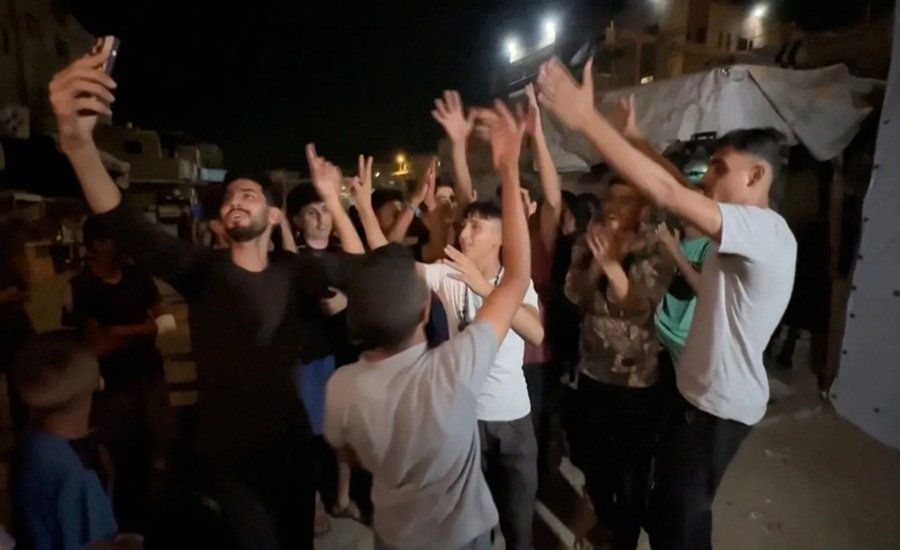Ahmed Almallahi
WASHINGTON, DC — Palestinians in the besieged Gaza woke up to a long-overdue news — Hamas and Israel agreed on the “first phase” of US-brokered peace deal that could finally end genocide in the coastal enclave.
Roba, a young Gaza woman displaced to Nuseirat camp, was initially incredulous upon hearing the news, telling TRT World she could not immediately believe it was happening.
She has lived through several ceasefires that quickly collapsed, most recently one in January that ended when Israel resumed its bombardment in March.
“I don’t want to celebrate too soon,” she said.
“After this genocide, nothing is as it was. There are no homes, no infrastructure, no schools or kindergartens — nothing left.”
Roba said her home was destroyed in the Israeli attacks, part of more than 90 percent of residential units across the enclave that have been levelled.
Unemployed and displaced, she said the future still looks uncertain.
“There’s no horizon, no future ahead. What awaits us could be as harsh as the past two years of genocide,” she said.
The agreement, which includes the release of hostages and a gradual Israeli withdrawal, has been hailed by US President Trump as “the first steps toward a strong, durable, and everlasting peace.”
Announced in Sharm el-Sheikh with mediation by Türkiye, Egypt, Qatar, and the US, the deal has been lauded by all involved.
But for those living under harsh Israeli siege, hope is tinged with exhaustion and fear of disappointment.

Palestinian paramedic Saeed Awad follows the news after the announcement ceasefire, as he stands at Al-Aqsa Hospital, in Deir al-Balah. — AP
‘We can rebuild our homes — and our lives’
Architect Mohammed Suhail called the development “a moment of relief” after two years of destruction and some 200,000 casualties among Palestinians, but remains cautious.
“We’ve lived through too many failed truces,” he told TRT World.
“But this time, I want to believe we can rebuild our homes — and our lives.”
Suhail said he hopes to contribute to reconstruction efforts once stability returns.
“If there’s real Arab and international support, Gaza can rise again quickly,” he said.
He believes rebuilding must start with people as much as with infrastructure.
“At least we can rebuild both the human spirit and the city,” he added.
His optimism echoes the UN’s call for a $7 billion reconstruction plan to restore hospitals, clinics and essential infrastructure in what it calls “the foundation for peace and recovery.”
‘My dream is to study again’
Ibrahim, a 19-year-old who completed high school with a score of 97 percent just before the war began, expressed his joy upon hearing news of a potential end to the Israeli bombardment.
“The genocide stopped me from going to university for two years, but it didn’t break my determination,” he told TRT World.
Ibrahim hopes to study electrical engineering abroad and is working on improving his English to qualify for a scholarship.
He urged international aid to assist Gaza students in reconstructing their futures.
“We’ve lost two years of education,” he said. “But young people here are resilient — we just need the world to help us start again.”
UNICEF estimates that 64,000 children have been killed or injured across Gaza in the past two years, calling the war “a hellish experience that has devastated an entire generation.”
‘We believe and don’t believe’
Eyad Amawi, a Palestinian aid coordinator displaced in central Gaza, told AP news agency that he has “mixed feelings, between happiness and sadness, memories — everything is mixed.”
“We believe and don’t believe,” he said, describing the emotional weight of hearing the ceasefire news after years of war.
Amawi said he hopes the deal will be implemented as agreed so that people can return to their homes and begin to “renew the will and the hope for life” in Gaza, where rubble and injury dominate the landscape.
His greatest fear, he said, is that Israel will place obstacles to the deal’s implementation. “The eyes of the Palestinians in Gaza are on how the world will help Gaza to rebuild,” he added.
“We need to fix everything here, especially the psychological effects, to continue with our lives.”
Amawi plans to return to Gaza City as soon as the deal takes effect to resume his work and assist with rehabilitation efforts.
He said the news of the deal came late in Gaza, so most people were asleep.
“The celebrations will be great. But also the sadness and the worries will be great also,” he said. To the world, Amawi said: “We need you.”
Between hope and survival
In Al-Mawasi, southern Gaza, anticipation filled the night. An AFP news agency source reported joyful chants of “Allahu akbar” and celebratory gunfire before the announcement.
“We’re closely following every bit of news about the negotiations and the ceasefire,” said 50-year-old Mohammed Zamlot, who had been expelled by Israel from northern Gaza.
While Gaza’s residents wait for signs that the ceasefire will hold, humanitarian officials say the war’s toll remains staggering: mass displacement, widespread hunger and the collapse of medical services.
The UN has urged immediate, unimpeded aid access and warned that any peace must be matched by large-scale reconstruction.
For now, people like Roba, Mohammed, Ibrahim, Zamlot and Eyad are left to navigate the fragile space between survival and the hope that this time, peace might finally last.

